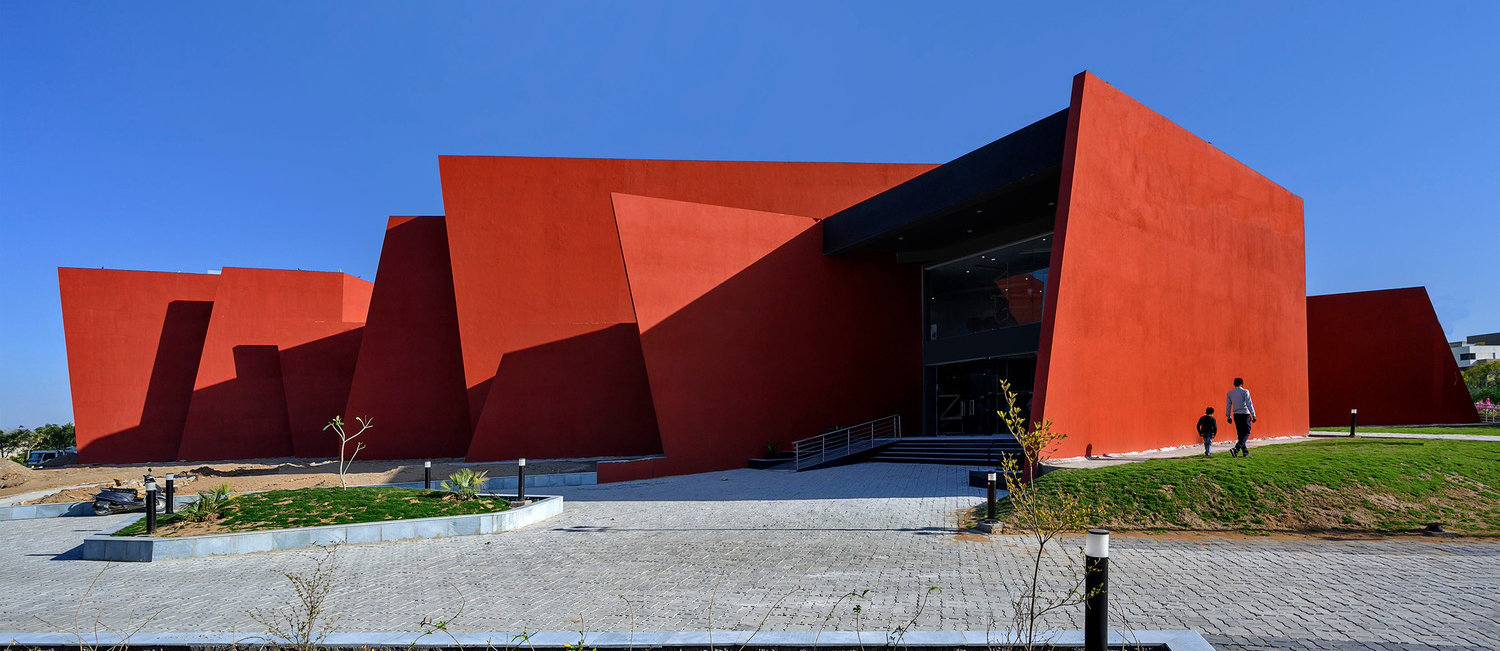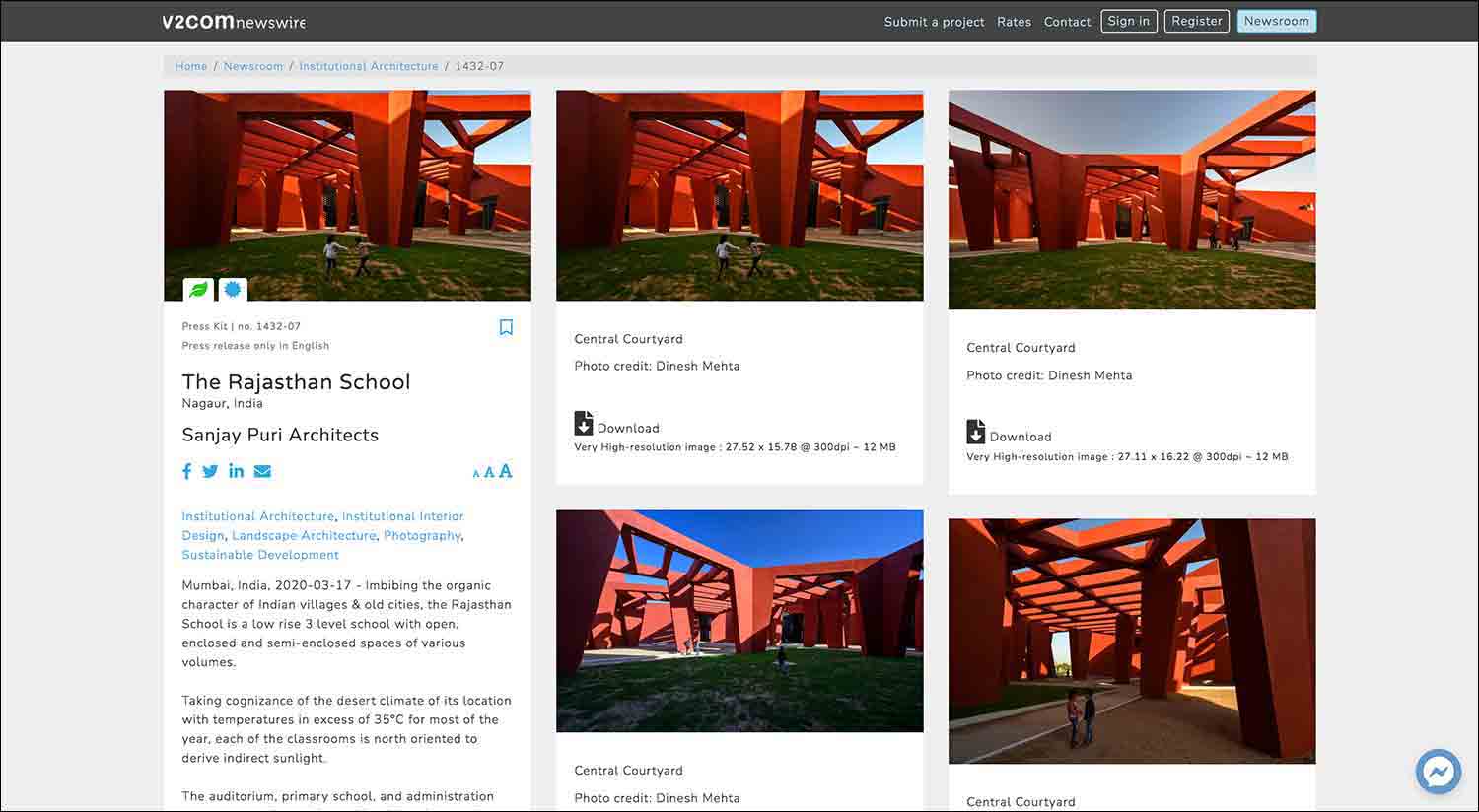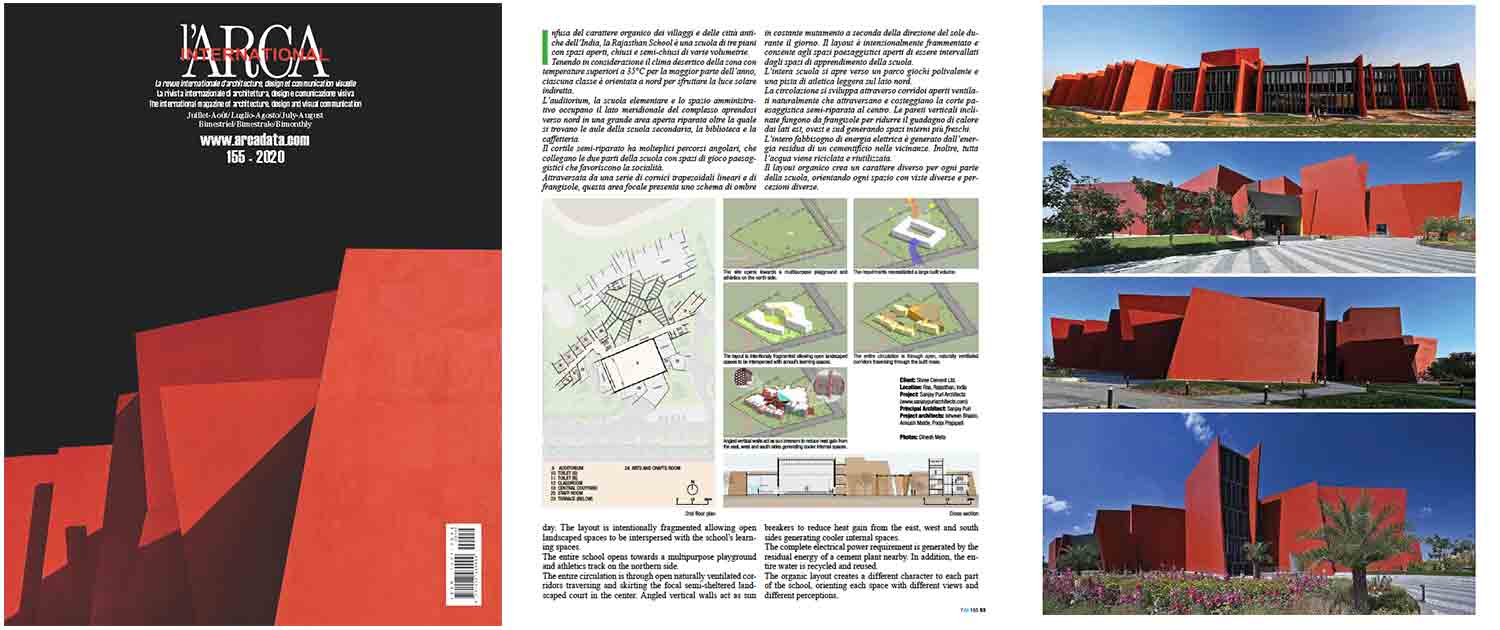
How to optimize your project’s media coverage
Case study: The Rajasthan School by Sanjay Puri Architects
An example of media coverage for an institutional architecture project
As experts with more than 25 years of experience in media relations for designers and architects, we know and understand the media’s needs, criteria and tastes. Having released thousands of projects and news items on the v2com newswire, we have a deep understanding of what works and what doesn’t. Even though it’s true that the needs of journalists and editorial teams differ from one publication to another, and from region to region and day to day, there are still some essential media-success factors for any architecture project.
How can I know whether my project will be successful? Will it please the media? How can I optimize my coverage? What rules do I have to follow to give myself the best chance of getting coverage in the most prestigious publications?
We’ll look at the success factors through a case study: The Rajasthan School by Sanjay Puri Architects, a project distributed on v2com. We’ll use it as a starting point for exploring specific factors, and you’ll see how some key aspects of a project and its press kit can have an impact on the results.

The project
The Rajasthan School by Sanjay Puri Architects
Contemporary architecture
Institutional | education
Construction of a new primary school in the Rajasthan Desert
The press kit
Press release in English
20 photographs, very high resolution
7 plans/concepts/technical drawings
Detailed technical sheet
Short description of the firm
Completion date: 2020
No embargo or other restrictions
Distribution
Release on the v2com newswire
No media relations
Release date: March 17, 2020
Sent to 6,509 specialized design, architecture and lifestyle media outlets
95 countries
4 categories
Results
1,494 media saw the project
47,216 page impressions
1,159 clicks
67 downloads
56 confirmed articles
4 print publications
52 online publications
2 magazine covers
Let’s take a closer look at the Rajasthan School project and its press kit, to understand how it met the various media success factors.
The factors
Type of news
The Rajasthan School project fits into the broad category of institutional projects, more specifically schools. Media specializing in design and architecture cover different kinds of news, depending on their readership. Some seek out general readers and pay more attention to residential design, while commercial and institutional projects tend to be covered by niche publications. In this case, the project is an institutional one whose aim is to improve the quality of life for students and society at large. This kind of news is catnip to specialized media, especially those with a professional (trade) readership. Beyond form and function, architecture has a clear, long-term social role. In addition to being a new architectural project (timely), this item is also about improving children’s lives (social aspect), making the news item even more relevant and providing an added incentive for media to want to publish it.
Originality of the news item
Media outlets take an interest in different kinds of news and projects, but it’s essential to stand out from the crowd and deliver an interesting and distinctive message. The Rajasthan School boasts a unique geographical setting, in the heart of a desert in India, the Rajasthan Desert. It’s quite literally off the beaten path. And that’s something media like. From a visual perspective, the highly dynamic red volumes are astonishing and impressive. It isn’t every day that we see a strikingly colourful school in an Indian desert. In addition to the project’s quality, it’s particularly attractive to the media because of its original architecture and unique socio-geographical setting.
Exclusivity and relevance of the news item
Two of the most important media coverage success factors are the item’s newsworthiness and exclusivity. A previously published project won’t be of interest to the media, because they’re always looking for novelty. The Rajasthan School had never been published, and that goes a long way to explaining its remarkable media success on v2com. All new, all original.
Take note, creative folks! It doesn’t matter if you’ve been working on your project for two years or ten, as long as the final images haven’t been made public it counts as a new project from the media’s perspective. I know you can sometimes – or often – grow weary of seeing the same project over and over again. Once it’s done, you just want to close the file and move on to the next one. But for us publicists, communicators, journalists and editors, the end of your project is just the start. It gives us the thrill of something new! What’s important is, as far as possible, to keep the completion date and the official opening (if any) in sync with the project’s unveiling in the media.
In this case, The Rajasthan School was completed in 2020 and its press materials were released just a few months later – an ideal timeframe. Most media won’t publish projects older than two years. They’re usually a little more forgiving with institutional and residential projects, as opposed to commercial ones open to the public such as restaurants, hotels, stores, etc. Nevertheless, a school is a public building and so the project’s release should ideally align with its opening date. And never forget the golden rule: the sooner the better.
Quality of the press materials
The press kit by Sanjay Puri Architects is a very thorough one. The press release is effective and to the point. The project description is highly detailed and the social message is intriguing. The high-resolution images are varied and numerous. It’s easy to grasp the different spaces, thanks to the inclusion of multiple angles and perspectives. This is a highly appreciated feature, especially for print magazines, which need to keep their visuals diverse. And, to complement the press release, there’s plenty of other material that’s useful for the media: technical sheet, company profile, plans, technical drawings and sketches. A comprehensive, high-quality press kit is one of the success factors if your aim is to make the media’s work easier and get published. A journalist who has to puzzle out a badly written press release, or who has to ask a lot of questions to clear up ambiguities, or request visuals or further information, is a journalist who sees barriers and irritants complicating their already busy schedule. So to improve your chances of getting published promptly and effectively, give the media a clear, concise and thorough press kit.
Number of images
As we all know, images are crucially important in design and architecture. Aside from the quality of the photographs, the number of photos also has an impact on results. Press kits with more than 15 images are more likely to get published. Those with more than 30 photos, or even up to 60 images (including both photos and plans) will see even more downloads, and therefore more articles.
Why? It’s simple. More images equal more options for the publication. By being able to select images from a large number of choices, editors have the advantage of being able to publish an article that’s tailored to their editorial style and distinct from other articles based on the same project. Lastly, the most important reason to offer dozens of images is that it will help print publications write comprehensive, multi-page articles. In other words, press kits with more photos and technical drawings often generate more in-depth articles.
In the case of The Rajasthan School, the press kit includes 20 images, which is the number included with v2com’s Standard distribution package – our most popular. In short, 15 images is the minimum for acceptable coverage, 20 is the recommended standard, and 30 or more will boost your chances of garnering even more coverage.
Media relations
Media relations are personalized follow-ups with key journalists and editors, using a planned strategy. Whether you handle such contacts internally or hire an outside firm, media relations can often improve your media coverage. However, The Rajasthan School is a perfect example of a project released on the v2com newswire without any personalized media contact at all. The project’s outstanding media success is based on the other factors discussed above. Very prestigious publications, both print and online, published articles about The Rajasthan School in the wake of its v2com release, thanks to a high-quality project and a press kit to match. It even made two magazine covers.
Still, even though they didn’t do media relations, Sanjay Puri and his team were very responsive and made themselves available to the media who downloaded their materials from v2com. They showed gratitude and openness, thanking them for their interest and responding quickly to questions and information requests. A simple follow-up when a media outlet shows interest can make a real difference: it can quickly convert an opportunity into real coverage.
So it’s possible, simply by distributing your press kit through v2com, to receive excellent global coverage. It can be helpful to add media relations when you want to target specific publications and manage exclusivity agreements. We’ll look into that subject in more detail in a future post.

Analysis
The average number of downloads on v2com for an institutional architecture project is around 25. The Rajasthan School’s press kit was downloaded 67 times. There were 4 printed articles and 52 online ones, for a total of 56. That’s an excellent ratio, because online publications publish far more articles than printed ones. A single online outlet can run 3 to 4 new articles daily – around 1300 a year – while a print publication will feature around 10 projects per issue, and typically run 6 issues a year, for a total of 60. That’s almost 20 times more digital than paper content, so it’s no surprise that there are usually more web than print articles.
In summary, Sanjay Puri Architects had plenty of coverage with 56 total articles. What happened with the other 11 downloads? There are a few possibilities. Some media may have published an article that could not be retrieved. Others downloaded the press kit with the intent of publishing an article eventually, but decided not to for any number of possible reasons. That’s why we want to stress the importance, already mentioned above, of following up with the media that download your project from v2com, to help ensure that a download (interest) is converted into coverage (article). Even if the media don’t always answer emails due to time constraints, a simple thanks-for-the-download is always appreciated.
…
To recap: the decisive factors that increase media interest and optimize your coverage are a good press release, plenty of high-quality professional photos, plans and technical details, a recent and unpublished project, an uncommon project or detail, and personalized follow-up with the media. Of course, a strong distribution network specializing in your field, like v2com for architecture and design, amplifies your coverage because it helps you make direct contact with the right target audience. Lastly, as mentioned in our previous case study , there’s also an uncontrollable random factor alongside all the controllable things that contribute to your coverage: timing. That’s why you should have a regular, ongoing media presence to increase your chances of a successful release.
Feel free to contact us if you have any questions about media coverage success factors, want advice on how to prepare your press kit, or wish to discuss the ideal media strategy for your next project.
v2com, you partner for media success
By Pénélope Fortin
A design graduate with a passion for communications, Pénélope Fortin has been in charge of media relations for designers and architects at v2com for 8 years. A creative, detail-oriented professional, she is in contact with media around the world and loves developing innovative media strategies for her clients.
